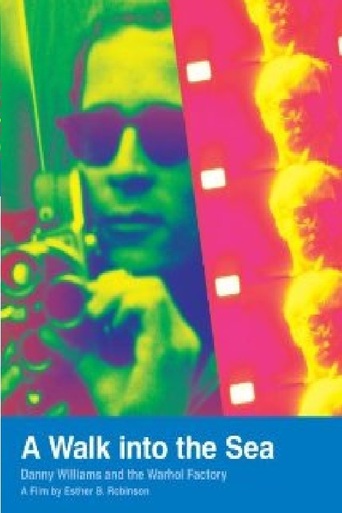Amanuencis
A Walk Into The Sea asks what and why. It follows a talented filmmaker into a world that most of us can only wonder about. The pacing and music slow us down and create images that allow us to feel, without analyzing, what might have led Danny Williams to walk into the sea and disappear. Esther Robinson, Danny's niece, sets out to learn more about her uncle's death in 1966. The video, with superb editing by co-writer Shannon Kennedy, and entrancing music by Todd Griffin, creates a murky, mysterious, collage of commentary by Warhol associates during the early 60's who skate around Danny's days and nights with Warhol and the Factory. Kennedy's juxtaposition of Factory members images from the 60's with Robinson's interviews from 2005-2007 create a gnawing sense of discomfort and a wish for a final answer. This is the beauty of the film.
jm10701
In this movie, some relatives of a minor flunky at Andy Warhol's Factory try to imply that Warhol was somehow responsible for the guy's disappearance hundreds of miles away in the middle of nowhere.It gives a strong impression (but doesn't say) that the relatives first tried extorting money from Warhol's estate and only decided to make this smear movie when that attempt failed. This attempt should fail too, joining the missing flunky in well-deserved obscurity.I gave it two stars only because it's slightly amusing that the guy's relatives would have the gall to do something so monumentally and so brazenly stupid. Warhol was a neurotic, talentless jerk, but if he or any of his gang took the trouble to murder a nobody like Danny Williams then pigs can fly and George W Bush is a genius. This movie is toxic garbage.
Cosmoeticadotcom
The film uncovers no murder plot, and reveals only that Warhol and his cohorts were unsympathetic bastards in real life, despite their public personae. Now, how many other films have reached this 'startling' conclusion? And, as for the purported subject of the film, Danny Williams? Well, he's as much of a cipher at the end of the film as he was at the beginning. Yes, his mother Nadia talks about her son, some 40 years dead, with startling clarity, the sort that is rare for a parent to have for their child. Usually, one hears gushing sentiments, but Nadia speaks openly of her son's drug use and homosexuality and
.well, that's about it. The truth is, for all her clarity on what he was, externally, after the fact, she really knew very little about her son. To her, as to us, he is a cipher. The only difference is that she obviously cares for the memory of her son. We, the audience, are not inclined to that emotion since the film never opens him up. Director Robinson had an opportunity to make a film of more substance about the Factory scene, yet- either out of the needed hard work to do so, or a lack of basic curiosity, chose to just lob a softball at us, where a Nolan Ryan-level fastball (high and inside) would have been the better pitch selection.In short, the film is circular and solipsistic, even though its center is a dead man. It is as intriguing as strobe effects, after two or more minutes, and really should have been a thing kept for the archive of Warholia, not the masses. In real life, no one knows what happened to Danny Williams, as his body was never found (the film's title is based on one of the theories of his death). In A Walk Into The Sea: Danny Williams And The Warhol Factory, no one ever knows what is what about Danny Williams: man, mind, art, life, nor soul As such, the film can only fairly be deemed a failure. My only questions are to what degree did Robinson's relation to Williams contribute to that failure (a fear to unleash information?), and lacking such a relation, would there have even been a point for her making the film? While the latter question's answer is rather easy to pin down, I suspect the former one will remain as missing as the sum of Williams.
JasparLamarCrabb
At 27, film maker/editor Danny Williams left his family home in Rockport, MA and vanished. He may or may not have drowned. It's a mystery his family has been living with for over 40 years. Williams, a Harvard grad and boy genius film editor (he worked with the Maysles on their early films) had been spending time with Andy Warhol and his art fart cronies at the Factory and may or may not have been pushed aside by that crowd. Through interviews with the likes of Brigid Berlin, Gerard Malanga, John Cale and others, film maker Esther Robinson (Williams' niece), portrays Warhol and his minions as petty, jealous and just plain nasty. Paul Morrissey claims to have no knowledge of Williams and his film-making contributions, while Berlin, Nat Finkelstein and Chuck Wein fully acknowledge his work. Robinson's documentary gets no closer to answering what happened to Williams, but instead offers up an expose of the Warhol Factory years like no other since Jean Stein's landmark book EDIE.


 AD
AD



